NOx Emission Prediction of Diesel Vehicles in Deep Underground Mines Using Ensemble Methods
Abstract
1. Introduction
2. Materials and Methods
2.1. Ensemble Methods
- Generation—creation of a set of models to be used further, usually redundant;
- Pruning—selection and training models;
- Integration—the output of the model generates the final result.
- Bootstrapping—at this stage, the algorithm creates diverse samples. From the training set different subsets are generated by random selection with replacement. This allows the possibility that within the sample the same instance could be selected multiple times.
- Training—bootstrap samples are trained independently and in parallel using weak learners.
- Aggregation—the last step, where an average of all predicted outputs is taken, known as soft voting.
- Creating data samples—similar to bagging, multiple bootstrap samples are created from the original dataset.
- Build trees—each decision tree is trained on each of the bootstrap samples using randomly chosen features.
- Boosted training—a series of boosting iterations is conducted, where each iteration builds a new model to correct the errors of the previous model.
- Prediction—the final prediction for a new data point is obtained by adding the predictions from each model in the ensemble, considering their respective weights.
2.2. Data Aggregation
2.3. Data Preparation
3. Results and Discussion
3.1. Results for One Working Shift Time Period
3.2. Results for the Different Time Period
4. Conclusions
- (1)
- The conducted statistical analysis and selection made of diesel engine LHD vehicles’ working parameters, which are most suitable for NOx emission prediction in deep underground mines.
- (2)
- The development of the procedure of source data cleaning and processing, NOx prediction model building, and analyzing factors which may influence the accuracy of prediction.
- (3)
- The comparison of two ensemble methods and showing their advantages and limitations for this specific engineering application, which was not previously reported in the literature.
Author Contributions
Funding
Data Availability Statement
Conflicts of Interest
References
- Zhang, H.; Li, B.; Karimi, M.; Saydam, S.; Hassan, M. Recent Advancements in IoT Implementation for Environmental, Safety, and Production Monitoring in Underground Mines. IEEE Internet Things J. 2023, 10, 14507–14526. [Google Scholar] [CrossRef]
- Zawadzka-Malota, I. Testing of mining explosives with regard to the content of carbon oxides and nitrogen oxides in their detonation products. J. Sustain. Min. 2015, 14, 173–178. [Google Scholar] [CrossRef]
- Acuna, E.I.; Lowndes, I.S. A review of primary mine ventilation system optimization. Interfaces 2014, 44, 163–175. [Google Scholar] [CrossRef]
- Oluwoye, I.; Dlugogorski, B.Z.; Gore, J.; Oskierski, H.C.; Altarawneh, M. Atmospheric emission of NOx from mining explosives: A critical review. Atmos. Environ. 2017, 67, 81–96. [Google Scholar] [CrossRef]
- Trzop, K.; Palka, D.; Szurgacz, D.; Sobik, L. Preventive measures to minimize natural hazards in the Polish underground mining industry. IOP Conf. Ser. Earth Environ. Sci. 2021, 684, 012009. [Google Scholar] [CrossRef]
- Cao, Y.; Ji, H.; Pei, F. Research on vertical change trend of environmental indicators of mining face and its assessment in gold mine. Min. Sci. 2017, 24, 99–115. [Google Scholar] [CrossRef]
- Zhang, H.; Fava, L.; Cai, M.; Vayenas, N.; Acuña, E. A hybrid methodology for investigating DPM concentration distribution in underground mines. Tunn. Undergr. Space Technol. 2021, 115, 104042. [Google Scholar] [CrossRef]
- Krot, P.; Zimroz, R.; Sliwinski, P.; Gomolla, N. Safe Operation of Underground Mining Vehicles Based on Cyclic Fatigue Monitoring of Powertrains. In Structural Integrity and Fatigue Failure Analysis; VCMF 2020. Structural Integrity; Lesiuk, G., Szata, M., Blazejewski, W., Jesus, A.M.d., Correia, J.A., Eds.; Springer: Cham, Switzerland, 2022; Volume 25, pp. 283–292. [Google Scholar] [CrossRef]
- Shin, S.; Lee, Y.; Kim, M.; Park, J.; Lee, S.; Min, K. Deep neural network model with Bayesian hyperparameter optimization for prediction of NOx at transient conditions in a diesel engine. Eng. Appl. Artif. Intell. 2022, 94, 103761. [Google Scholar] [CrossRef]
- Yuan, Z.; Meng, L.; Gu, X.; Bai, Y.; Cui, H.; Jiang, C. Prediction of NOx emissions for coal-fired power plants with stacked-generalization ensemble method. Fuel 2021, 289, 119748. [Google Scholar] [CrossRef]
- Meira, E.; Oliveira, F.L.C.; de Menezes, L.M. Forecasting natural gas consumption using Bagging and modified regularization techniques. Energy Econ. 2022, 106, 105760. [Google Scholar] [CrossRef]
- Lv, Y.; Liu, J.; Yang, T.; Zeng, D. A novel least squares support vector machine ensemble model for NOx emission prediction of a coal-fired boiler. Energy 2013, 55, 319–329. [Google Scholar] [CrossRef]
- Park, M.H.; Hur, J.J.; Lee, W.J. Prediction of oil-fired boiler emissions with ensemble methods considering variable combustion air conditions. J. Clean. Prod. 2022, 375, 134094. [Google Scholar] [CrossRef]
- Andersen, Z.J.; Hvidberg, M.; Jensen, S.S.; Ketzel, M.; Loft, S.; Sørensen, M.; Tjønneland, A.; Overvad, K.; Raaschou-Nielsen, O. Chronic obstructive pulmonary disease and long-term exposure to traffic-related air pollution: A cohort study. Am. J. Respir. Crit. Care Med. 2011, 183, 455–461. [Google Scholar] [CrossRef]
- Shaw, S.; Van Heyst, B. An evaluation of risk ratios on physical and mental health correlations due to increases in ambient nitrogen oxide (NOx) concentrations. Atmosphere 2022, 13, 967. [Google Scholar] [CrossRef]
- Subramaniam, N.; Yusof, N. Modelling of CO2 emission prediction for dynamic vehicle travel behavior using ensemble machine learning technique. In Proceedings of the 2021 IEEE 19th Student Conference on Research and Development (SCOReD), Kota Kinabalu, Malaysia, 23–25 November 2021; pp. 383–387. [Google Scholar] [CrossRef]
- Abdelsalam, E.M.; Mohamed, Y.M.A.; Abdelkhalik, S.; Nazer, H.A.E.; Attia, Y.A. Photocatalytic oxidation of nitrogen oxides (NOx) using Ag- and Pt-doped TiO2 nanoparticles under visible light irradiation. Environ. Sci. Pollut. Res. 2020, 27, 35828–35836. [Google Scholar] [CrossRef]
- Acharya, R.; Alam, M.; Boehman, A. Fuel and System Interaction Effects on Urea-SCR Control of NOx in Diesel Exhaust Aftertreatment; SAE Technical Paper; SAE: Warrendale, PA, USA, 2006; 2006-01-0638. [Google Scholar] [CrossRef]
- Funk, S. Real world NOx sensor accuracy assessment and implications for REAL NOx tracking. SAE Int. J. Adv. and Curr. Prac. Mobil. 2021, 3, 2761–2769. [Google Scholar] [CrossRef]
- Irfan, M.F.; Goo, J.H.; Kim, S.D. Co3O4 based catalysts for NO oxidation and NOx reduction in fast SCR process. Appl. Catal. B Environ. 2008, 78, 267–274. [Google Scholar] [CrossRef]
- Halim, A. Ventilation requirements for diesel equipment in underground mines–Are we using the correct values. In Society for Mining, Metallurgy and Exploration 2017, Proceedings of the 16th North American Mine Ventilation Symposium, Golden, CO, USA, 17–22 June 2017; Brune, J.F., Ed.; Volume 27, pp. 1–7. Available online: http://www.diva-portal.org/smash/get/diva2:1134809/ATTACHMENT01.pdf (accessed on 1 February 2024).
- Mabahwi, N.A.B.; Leh, O.L.H.; Omar, D. Human health and wellbeing: Human health effect of air pollution. Procedia-Soc. Behav. Sci. 2014, 153, 221–229. [Google Scholar] [CrossRef]
- Agarwal, A.K.; Mustafi, N.N. Real-world automotive emissions: Monitoring methodologies, and control measures. Renew. Sustain. Energy Rev. 2021, 137, 110624. [Google Scholar] [CrossRef]
- Duan, K.; Li, Q.; Liu, H.; Zhou, F.; Lu, J.; Zhang, X.; Zhang, Z.; Wang, S.; Ma, Y.; Wang, X. Dynamic NOx emission factors for main engines of bulk carriers. Transp. Res. Part D Transp. Environ. 2022, 107, 103290. [Google Scholar] [CrossRef]
- Krot, P.; Sliwinski, P.; Zimroz, R.; Gomolla, N. The identification of operational cycles in the monitoring systems of underground vehicles. Measurement 2020, 151, 107111. [Google Scholar] [CrossRef]
- Arrègle, J.; López, J.J.; Guardiola, C.; Monin, C. On board NOx prediction in diesel engines: A physical approach. In Automotive Model Predictive Control; Lecture Notes in Control and Information Sciences; Del Re, L., Allgöwer, F., Glielmo, L., Guardiola, C., Kolmanovsky, I., Eds.; Springer: London, UK, 2010; Volume 402, pp. 25–36. [Google Scholar] [CrossRef]
- Sadeghi, S.; Soltanmohammadlou, N.; Nasirzadeh, F. Applications of wireless sensor networks to improve occupational safety and health in underground mines. J. Saf. Res. 2022, 83, 8–25. [Google Scholar] [CrossRef]
- López-de Abajo, L.; Alberti, M.G.; Gálvez, J.C. Pollutant concentration prediction from traffic data analysis for concrete durability studies in Madrid Calle 30 urban tunnels. Tunn. Undergr. Space Technol. 2024, 144, 105477. [Google Scholar] [CrossRef]
- Banasiewicz, A.; Moosavi, F.; Kotyla, M.; Śliwiński, P.; Krot, P.; Wodecki, J.; Zimroz, R. Forecasting of NOx Emissions of Diesel LHD Vehicles in Underground Mines—An ANN-Based Regression Approach. Appl. Sci. 2023, 13, 9965. [Google Scholar] [CrossRef]
- Banasiewicz, A.; Śliwiński, P.; Krot, P.; Wodecki, J.; Zimroz, R. Prediction of NOx Emission Based on Data of LHD On-Board Monitoring System in a Deep Underground Mine. Energies 2023, 16, 2149. [Google Scholar] [CrossRef]
- Barutçuoğlu, Z.; Alpaydın, E. A comparison of model aggregation methods for regression. In International Conference on Artificial Neural Networks; Springer: Berlin/Heidelberg, Germany, 2003; pp. 76–83. [Google Scholar] [CrossRef]
- Breiman, L. Bagging predictors. Mach. Learn. 1996, 24, 123–140. [Google Scholar] [CrossRef]
- Freund, Y. Boosting a Weak Learning Algorithm by Majority. Inf. Comput. 1995, 121, 256–285. [Google Scholar] [CrossRef]
- Friedman, J.H. Greedy function approximation: A gradient boosting machine. Ann. Stat. 2001, 29, 1189–1232. [Google Scholar] [CrossRef]
- Hastie, T.; Tibshirani, R.; Friedman, J.H. The Elements of Statistical Learning: Data Mining, Inference, and Prediction; Springer: New York, NY, USA, 2009; Volume 2. [Google Scholar] [CrossRef]
- Sharma, M.; Maity, T. Review on machine learning-based underground coal mines gas hazard identification and estimation techniques. Arch. Comput. Methods Eng. 2023, 31, 371–388. [Google Scholar] [CrossRef]
- Mendes-Moreira, J.; Soares, C.; Jorge, A.M.; Sousa, J.F.D. Ensemble approaches for regression: A survey. ACM Comput. Surv. 2012, 45, 1–40. [Google Scholar] [CrossRef]
- KGHM ZANAM LHD LKP-1701. Available online: https://www.kghmzanam.com/wp-content/uploads/2020/12/LKP_1701_PL.pdf (accessed on 16 December 2023).
- DEUTZ TCD 12.0 and TCD 16.0 Diesel Engines. Available online: https://www.deutzsupport.com/product-details/tcd-12-0-and-tcd-16-0/ (accessed on 16 December 2023).
- ISO 14396:2002; Reciprocating internal combustion engines Determination and method for the measurement of engine power. ISO: Geneva, Switzerland, 2002.
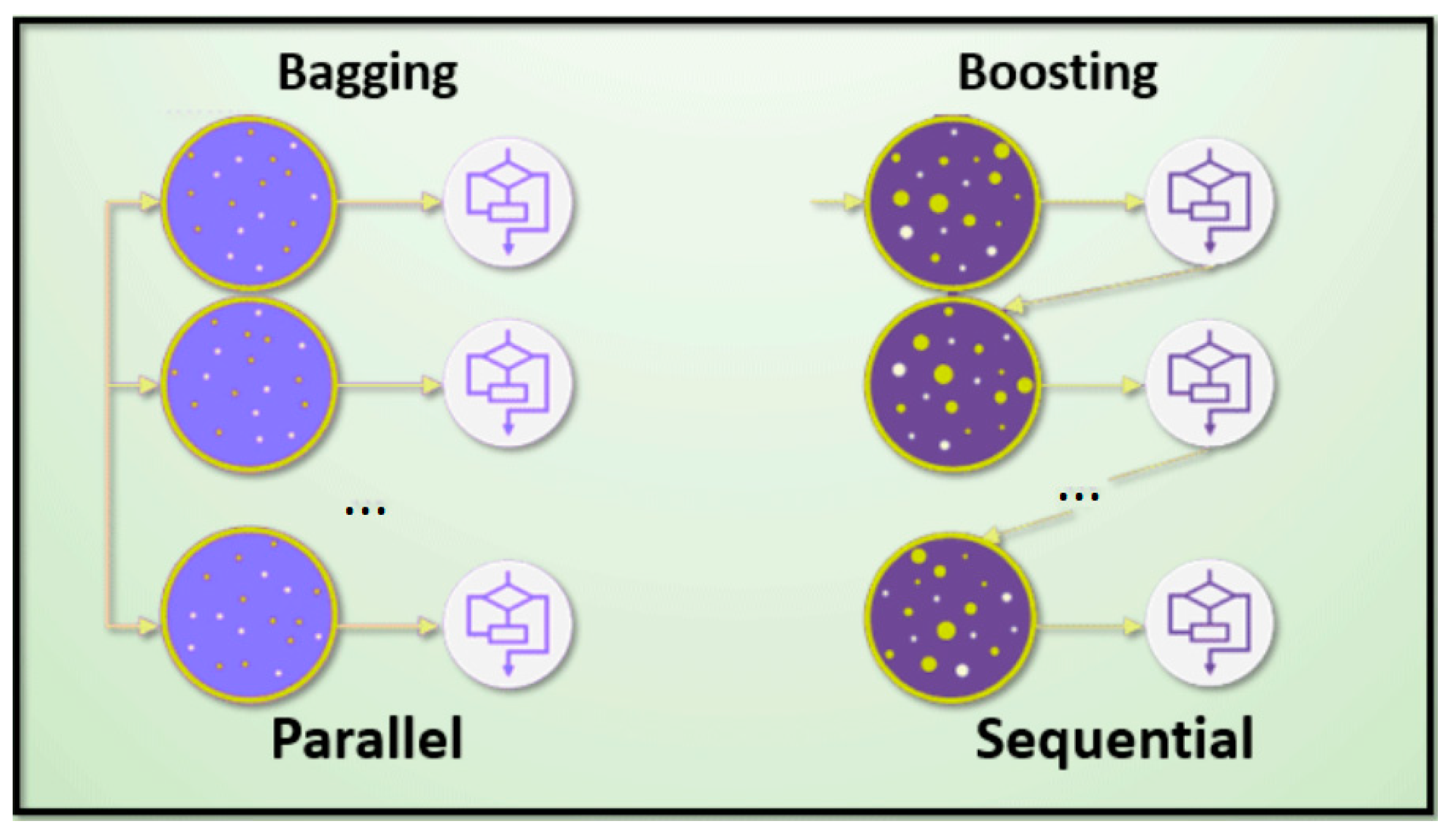

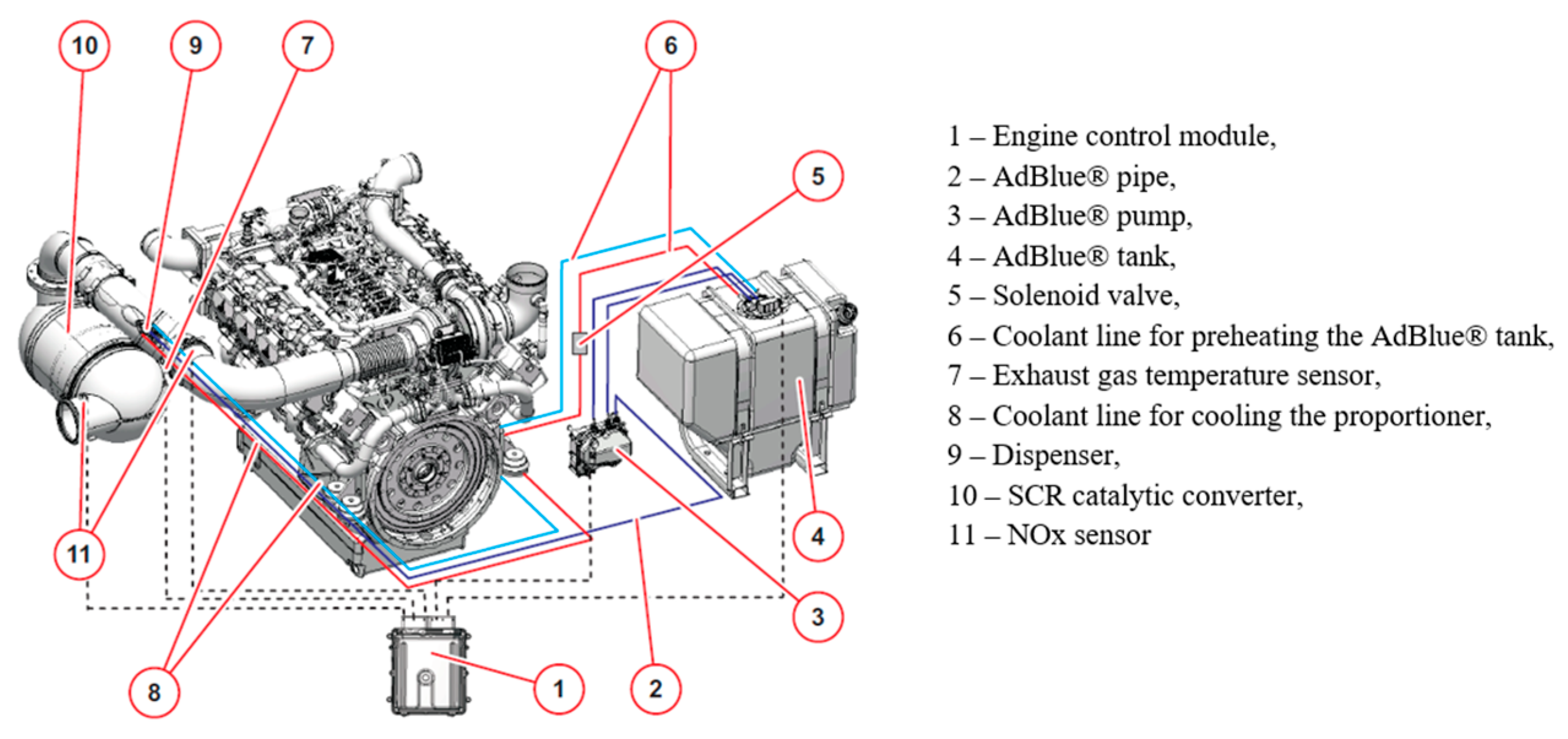
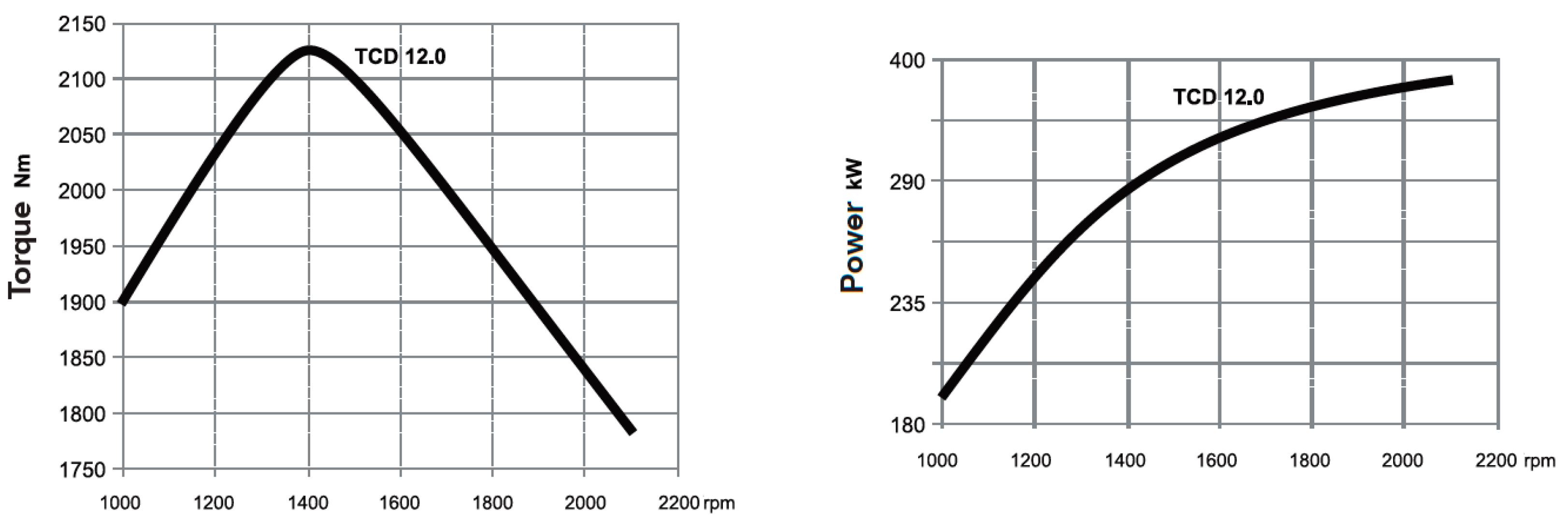
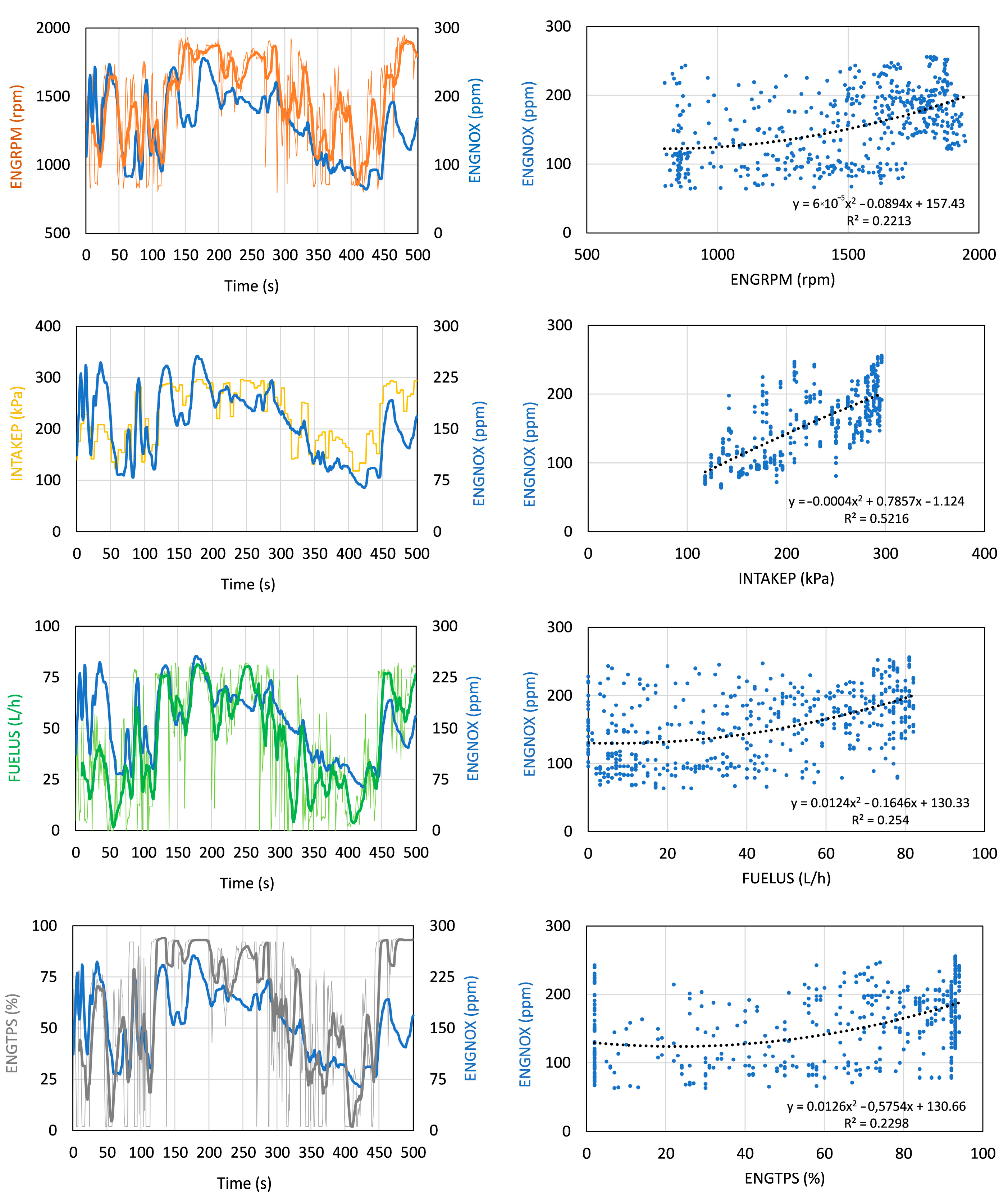


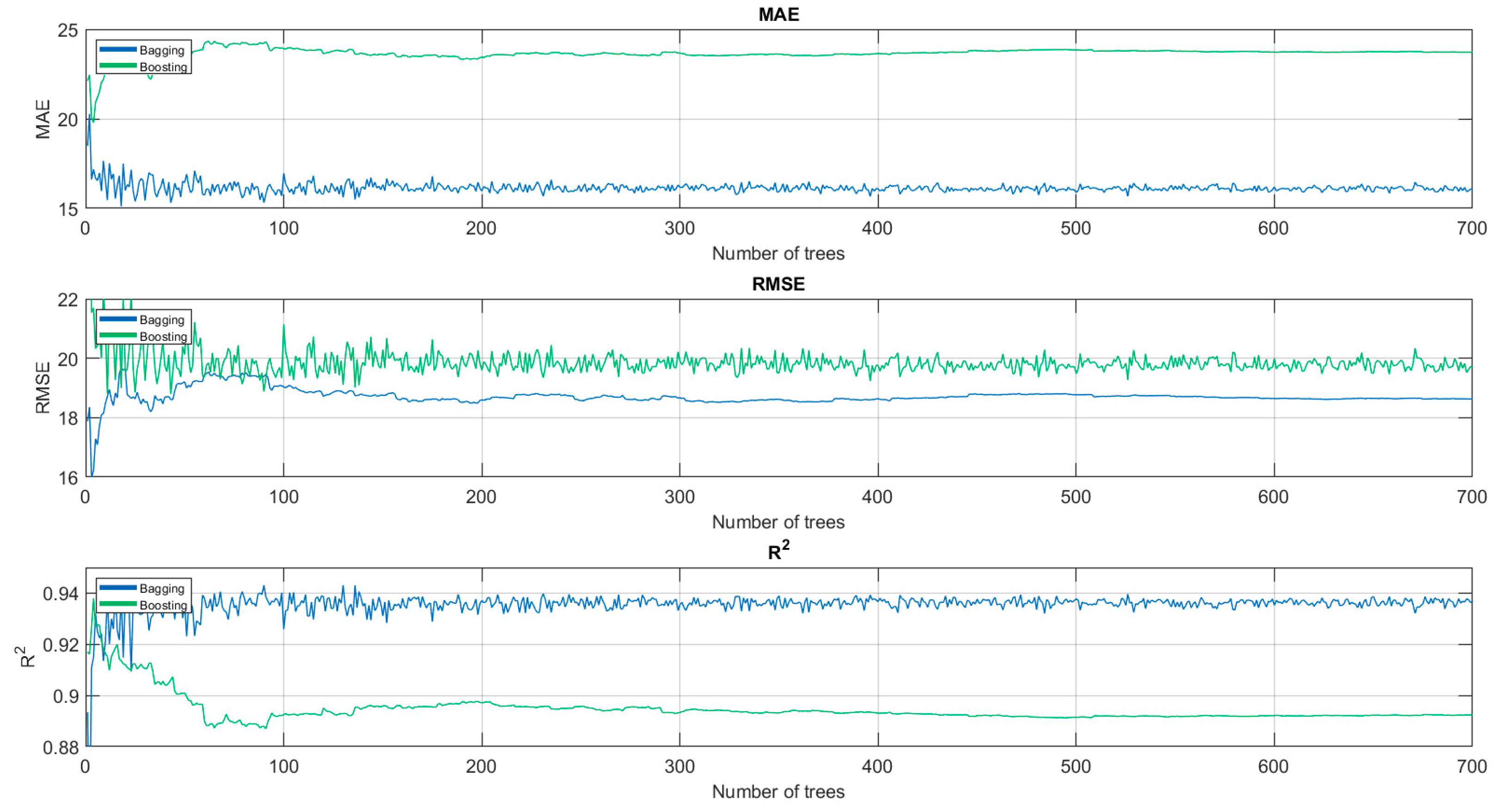
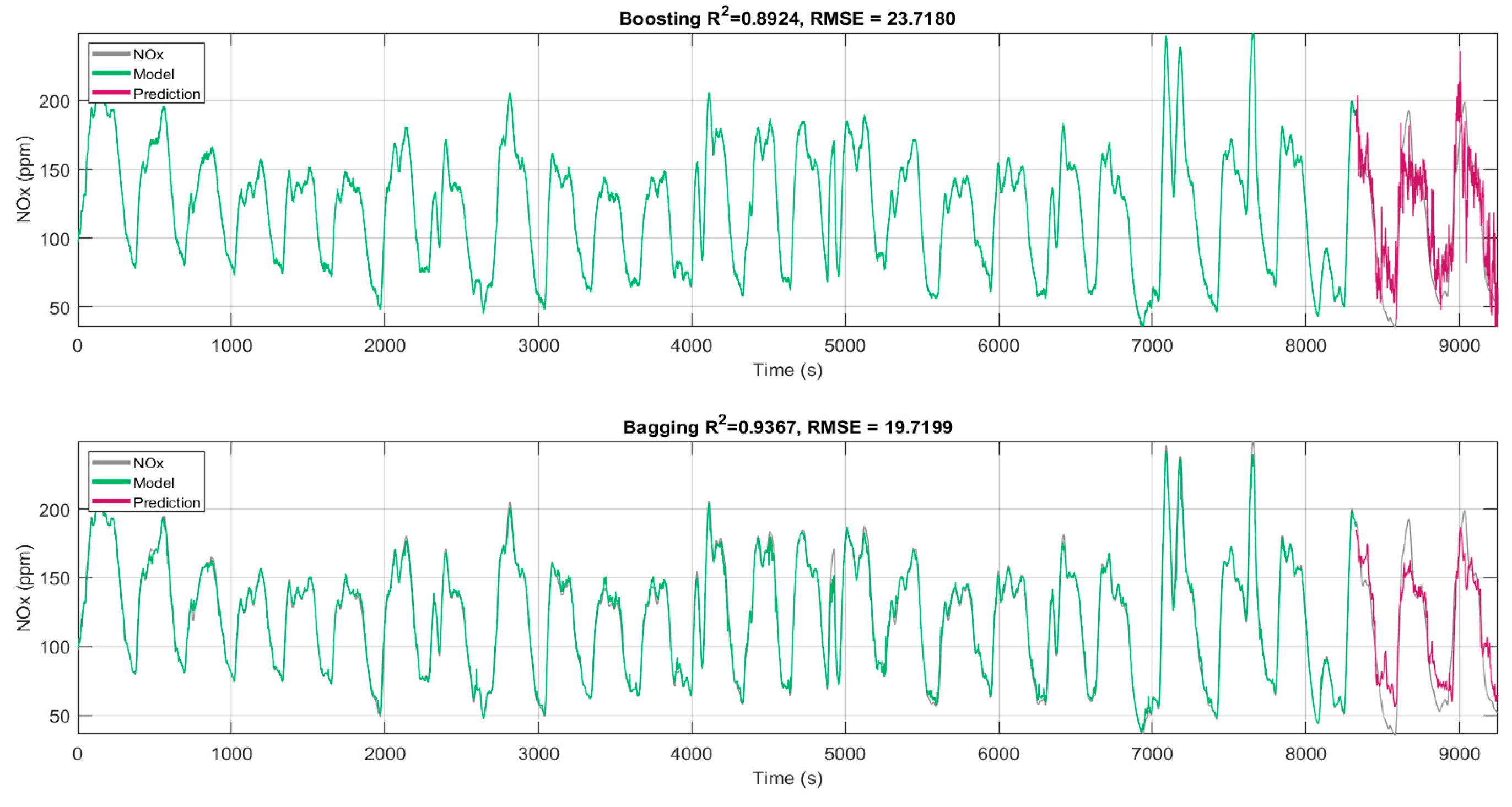
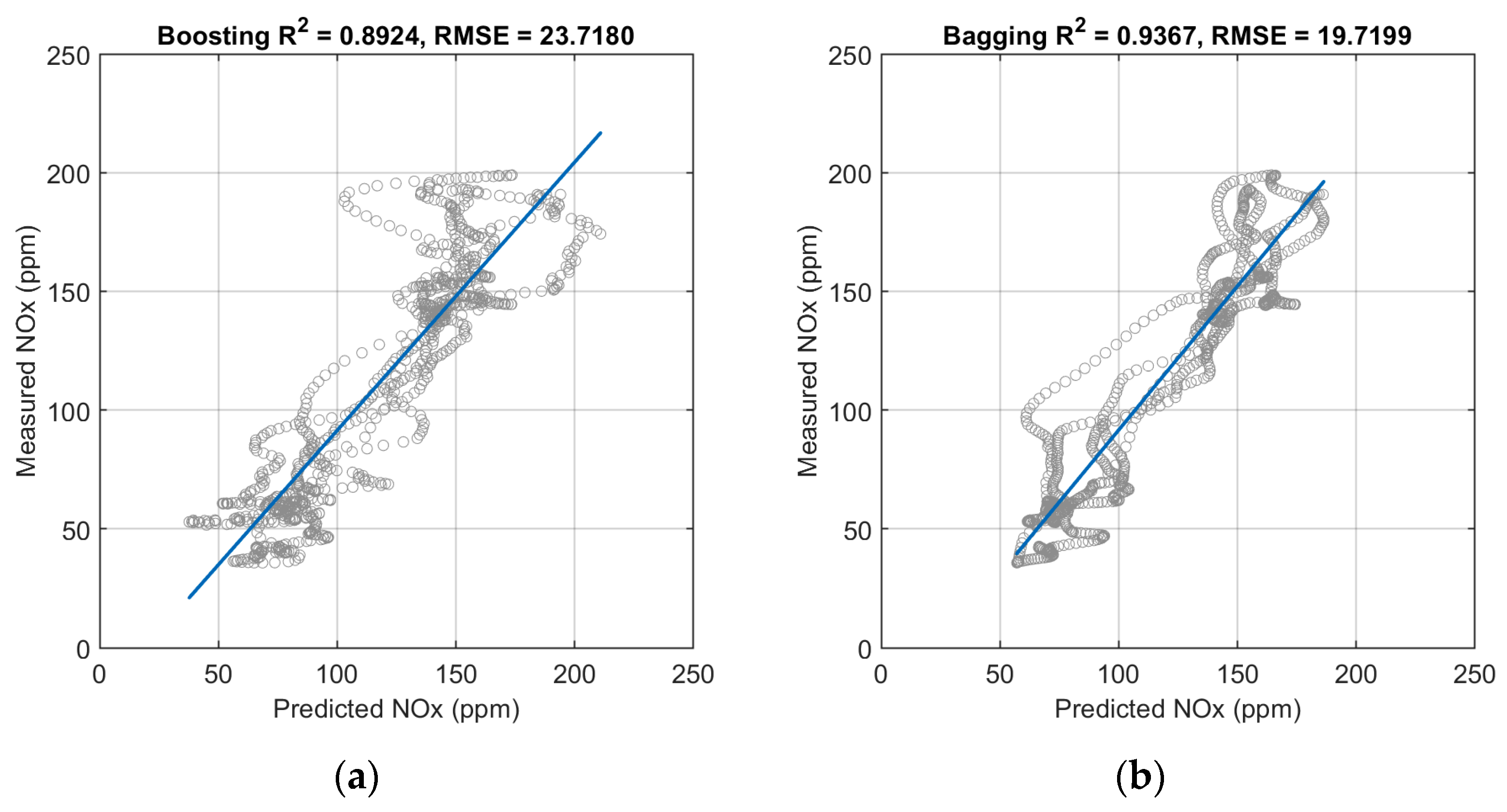


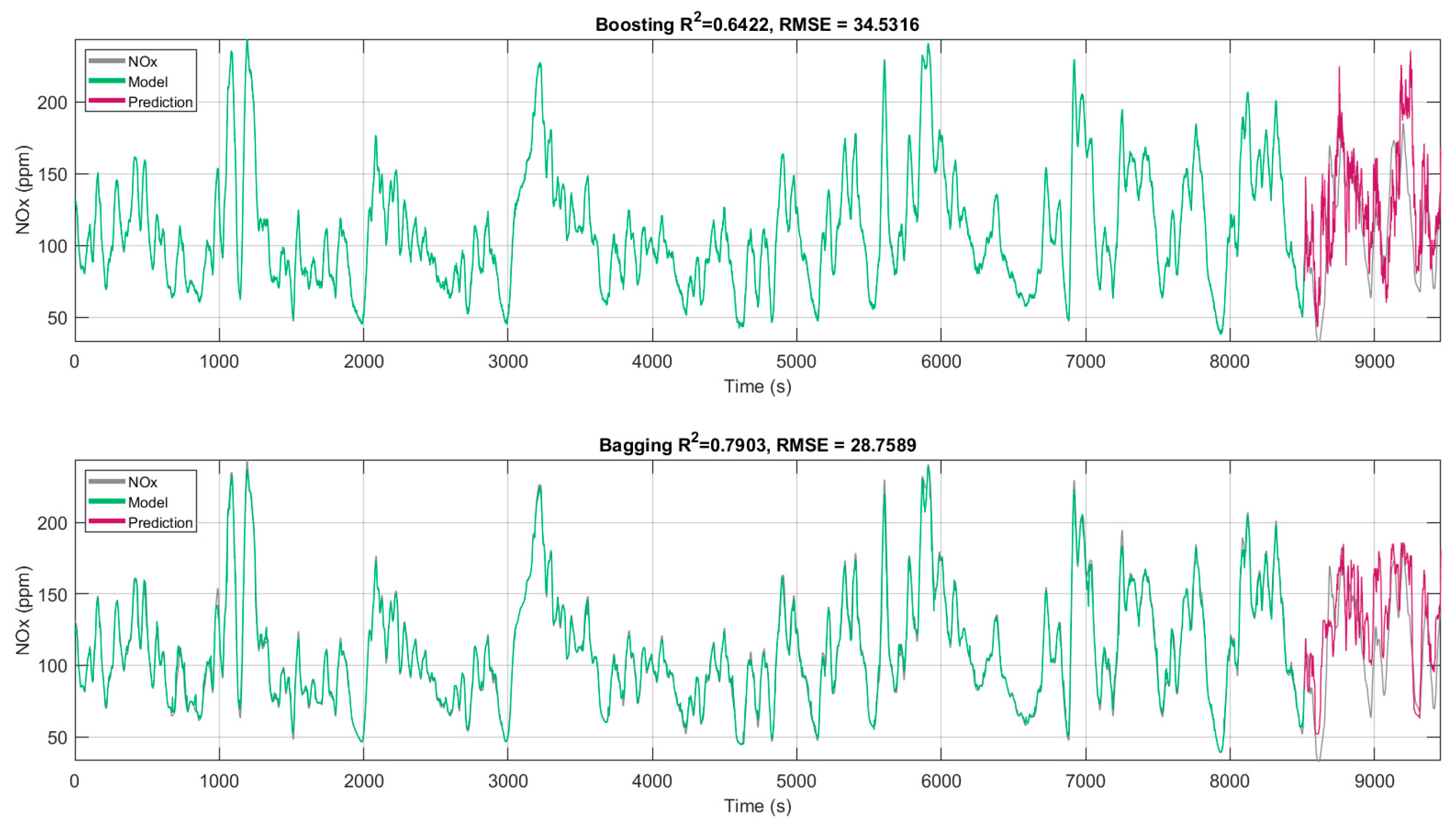

| Parameter | Value | Units |
|---|---|---|
| Power output (ISO 14396) [40] | 390 | kW |
| at speed | 2100 | rpm |
| Max. torque | 2130 | Nm |
| at speed | 1400 | rpm |
| Min. idling speed | 600 | rpm |
| Specific fuel consumption | 194 | g/kWh |
| Parameter | Value | Units |
|---|---|---|
| Measuring range (NOx) | 0–1500 | ppm |
| Accuracy | ±10 (20) | % |
| Operating temperature | −40… + 105 | °C |
| Exhaust gas temperature | <800 | °C |
| Nr | Parameter | Description | Units |
|---|---|---|---|
| 0 | ENGNOX | Engine NOx emissions | ppm |
| 1 | ENGCOOLT | Engine coolant temperature | °C |
| 2 | ENGOILP | Engine oil pressure | kPa |
| 3 | ENGRPM | Engine rotations | rpm |
| 4 | ENGTPS | Engine acceleration | % |
| 5 | FUELUS | Fuel consumption | L/h |
| 6 | GROILP | Gear oil pressure | kPa |
| 7 | GROILT | Gear oil temperature | °C |
| 8 | HYDOILP | Hydraulic oil pressure | MPa |
| 9 | INTAKEP | Intake air pressure | kPa |
| 10 | INTAKET | Intake air temperature | °C |
| 11 | SPEED | Vehicle speed | km/h |
Disclaimer/Publisher’s Note: The statements, opinions and data contained in all publications are solely those of the individual author(s) and contributor(s) and not of MDPI and/or the editor(s). MDPI and/or the editor(s) disclaim responsibility for any injury to people or property resulting from any ideas, methods, instructions or products referred to in the content. |
© 2024 by the authors. Licensee MDPI, Basel, Switzerland. This article is an open access article distributed under the terms and conditions of the Creative Commons Attribution (CC BY) license (https://creativecommons.org/licenses/by/4.0/).
Share and Cite
Kotyla, M.; Banasiewicz, A.; Krot, P.; Śliwiński, P.; Zimroz, R. NOx Emission Prediction of Diesel Vehicles in Deep Underground Mines Using Ensemble Methods. Electronics 2024, 13, 1095. https://doi.org/10.3390/electronics13061095
Kotyla M, Banasiewicz A, Krot P, Śliwiński P, Zimroz R. NOx Emission Prediction of Diesel Vehicles in Deep Underground Mines Using Ensemble Methods. Electronics. 2024; 13(6):1095. https://doi.org/10.3390/electronics13061095
Chicago/Turabian StyleKotyla, Michalina, Aleksandra Banasiewicz, Pavlo Krot, Paweł Śliwiński, and Radosław Zimroz. 2024. "NOx Emission Prediction of Diesel Vehicles in Deep Underground Mines Using Ensemble Methods" Electronics 13, no. 6: 1095. https://doi.org/10.3390/electronics13061095
APA StyleKotyla, M., Banasiewicz, A., Krot, P., Śliwiński, P., & Zimroz, R. (2024). NOx Emission Prediction of Diesel Vehicles in Deep Underground Mines Using Ensemble Methods. Electronics, 13(6), 1095. https://doi.org/10.3390/electronics13061095









